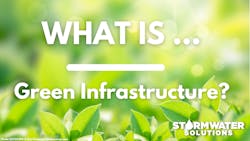In an era that is deeming resiliency more necessary, many are turning to new ways of managing stormwater. And one of those ways is through green infrastructure (GI).
According to American Rivers, “green infrastructure is an approach to water management that protects, restores, or mimics the natural water cycle. Green infrastructure is effective, economical, and enhances community safety and quality of life.”
According to The U.S. Environmental Protection Agency (EPA), “In 2019, Congress enacted the Water Infrastructure Improvement Act, which defines green infrastructure as "the range of measures that use plant or soil systems, permeable pavement or other permeable surfaces or substrates, stormwater harvest and reuse, or landscaping to store, infiltrate, or evapotranspirate stormwater and reduce flows to sewer systems or to surface waters."
GI benefits
In a society that is increasingly prioritizing sustainability, green infrastructure is taking a seat at the table for myriad reasons. According to the EPA, green infrastructure brings many benefits, whether that is in regard to water quality and quantity, air quality, climate resiliency, habitat wildlife and communities.
When it comes to water quality and quantity, EPA reports that GI can “mitigate flood risk by slowing and reducing stormwater discharges,” unlike conventional stormwater infrastructure that typically quickly drains stormwater to rivers, streams and other waterways, which increases peak flows and flood risk. GI can also positively impact water supply and private and public cost savings.
In terms of climate resiliency, GI can help replenish groundwater reserves, reduce urban heat island effect, lower building energy demands and provide protection to coastal areas.
“GI can help to reduce those peak flows and alleviate flooding and basement backups. GI practices can be effective in reducing wet-weather flows to combined sewer systems, reducing combined sewer overflows to local waterways, and reducing runoff volumes and improving water quality,” The Metropolitan Water Reclamation District of Greater Chicago website said.
Green infrastructure can be implemented in many ways. Below are some ideas found on EPA’s website.
- Downspout Disconnection
- Rainwater Harvesting
- Rain Gardens
- Planter Boxes
- Bioswales
- Permeable Pavements
- Green Streets and Alleys
- Green Parking
- Green Roofs
- Urban Tree Canopy
- Land Conservation
Green infrastructure barriers
Despite the myriad benefits GI brings with it, that is not to say it does not come without challenges. One such challenge, according to the EPA, is that GI practices “are often perceived as emerging technologies with a limited track record.” However, data is available on both national and local levels.
Additionally, new and innovative approaches often come with higher design and construction costs. While long-term data is still being collected on maintenance costs, the EPA does offer a guide on cost-benefit resources that can be found here.
With unfamiliarity of maintenance requirements and costs, the EPA said that some local governments are hesitant to implement GI, and not only that, zoning density standards, storm sewer connection requirements, and minimum parking and road widths can also prove challenging to overcome.
However, there are solutions that can clear the path to implementing GI, such as creating and developing a design guidance, updating development codes, creating a maintenance program and more.
GI examples
There are numerous ways to implement GI in cities and states. Below are a few examples from around the country where states are working with citizens, municipalities and more to bring GI to their communities.
In Washington, Washington State University and the Stewardship Partners are working to install 12,000 rain gardens throughout the Seattle/Puget Sound Region. The campaign website reported that meeting the goal of installing 12,000 rain gardens would soak up 160 million gallons of polluted runoff.
In Chicago, the Metropolitan Reclamation District of Greater Chicago has teamed up with Chicago Public Schools, the Chicago Department of Water Management, Healthy Schools and Openlands to elevate elementary school playgrounds using GI. The GI features capture rainfall, reduce the load on the combined sewer system and help keep the city’s water resources clean, which results in less flooding. The 30 schools involved in the program have “the ability to capture 5,555,403 gallons, equivalent to 8.4 Olympic-sized swimming pools.”
New York City’s Department of Environmental Protection has various GI efforts, one of which is the Bluebelt Program, which was originally implemented in Staten Island. The program “preserves natural drainage corridors including streams, ponds, and wetlands, and enhances them to perform their functions of conveying, storing, and filtering runoff precipitation or stormwater.”
In Conclusion
As the EPA says, “green infrastructure elements can be woven into a community at several scales.” While GI efforts may vary by region, keep in mind that “when green infrastructure systems are installed throughout a community, city or across a regional watershed, they can provide cleaner air and water as well as significant value for the community with flood protection, diverse habitat, and beautiful green spaces,” the EPA’s website said.
About the Author
Katie Johns
Editor-in-Chief
Katie Johns, editor-in-chief of Stormwater Solutions, graduated from the University of Missouri in 2016 with a Bachelor of Journalism and a Bachelor of Arts in Spanish. Johns joined the Stormwater Solutions team in September 2019. Johns also helps plan the annual StormCon conference and co-hosts the Talking Under Water podcast. Prior to entering the B2B industry, she worked as a newspaper reporter and editor in Sarasota, Florida, and a magazine assistant editor in the Chicago suburbs. She can be reached at [email protected].
Sign up for our eNewsletters
Get the latest news and updates



